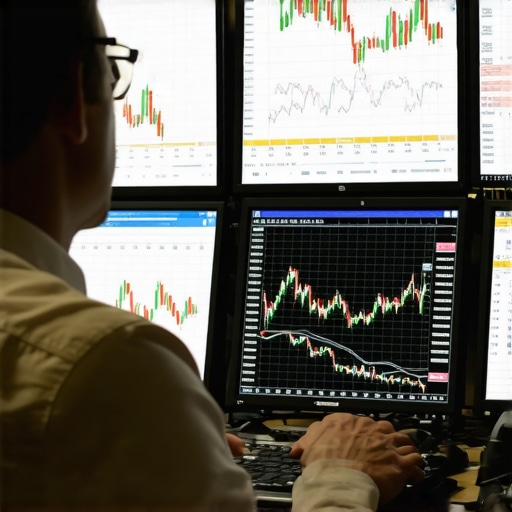Unlocking the Power of Gold Futures and Technical Analysis for 2025 Market Triumphs
In the evolving landscape of commodity trading, gold remains a perennial favorite for investors seeking stability and growth. As we approach 2025, mastering the intricacies of gold futures coupled with advanced technical analysis becomes paramount for discerning traders aiming to optimize their market strategies. This article delves into sophisticated approaches that leverage historical data, macroeconomic indicators, and cutting-edge analytical tools to navigate the complex gold market with confidence.
The Intersection of Gold Futures and Market Dynamics: An Expert Perspective
Gold futures serve as vital instruments for hedging against inflation and geopolitical risks, offering traders the ability to capitalize on anticipated price movements. Understanding how to interpret futures data in conjunction with macroeconomic trends—such as central bank policies and currency fluctuations—is essential for positioning effectively. According to recent market forecasts, gold prices in 2025 are likely to be influenced by shifts in global monetary policy and emerging demand from developing economies.
Advanced Technical Analysis Techniques for Gold
What Are the Most Reliable Indicators for Predicting Gold Price Trends?
Expert traders rely on a combination of moving averages, Fibonacci retracement levels, and oscillators such as RSI and MACD to identify potential turning points. In particular, analyzing volume trends alongside price patterns enhances predictive accuracy. For instance, divergences between price and RSI often signal potential reversals, providing strategic entry or exit points.
Further, integrating Elliott Wave theory can reveal complex market cycles, while candlestick pattern recognition offers real-time signals for short-term movements. These tools, when used collectively, create a robust analytical framework that helps mitigate risks and maximize profit potential.
Strategic Application of Technical Analysis in 2025
Effective application requires not only technical proficiency but also contextual awareness of macroeconomic factors. For example, a breakout above resistance levels combined with rising inflation expectations could signal a bullish trend, encouraging long positions in gold futures. Conversely, signs of economic stabilization and tightening monetary policy might suggest a consolidation phase or a bearish outlook.
It is crucial to remain adaptable, continuously updating your analysis with new data and market developments. Utilizing trading platforms that integrate real-time news feeds and economic calendars can significantly enhance decision-making precision.
How Can Traders Balance Risk and Opportunity in Gold Futures?
Risk management is integral to successful trading. Implementing stop-loss orders, diversifying across gold-related assets such as ETFs and physical bullion, and employing position sizing strategies are essential practices. Additionally, understanding the impact of currency fluctuations, especially the US dollar, on gold prices can help refine trade entries and exits.
For those seeking to deepen their understanding, exploring comprehensive guides like how to use gold futures and technical analysis can provide invaluable insights into integrating these tools effectively.
Conclusion
As 2025 approaches, the confluence of sophisticated technical analysis and strategic futures trading offers a compelling pathway for market success. By leveraging in-depth market knowledge, advanced analytical techniques, and disciplined risk management, traders can position themselves advantageously amidst the evolving gold market landscape. Continuous learning and adaptation remain the keystones of sustained profitability in this dynamic environment.
Innovative Approaches to Gold Futures Trading and Market Forecasting
As gold continues to be a cornerstone of wealth preservation and a hedge against economic volatility, mastering advanced trading strategies becomes crucial for investors aiming to capitalize on upcoming market movements in 2025. Beyond basic technical analysis, integrating multi-layered data sets—such as macroeconomic indicators, geopolitical developments, and currency trends—can elevate your trading acumen to an expert level.
How Do Macro Trends Shape Gold Futures Opportunities?
Understanding the broader economic landscape is essential. Central bank policies, especially interest rate adjustments and quantitative easing measures, directly influence gold prices and futures markets. For instance, when major economies signal monetary tightening, gold often reacts with price stabilization or declines; conversely, easing policies tend to boost gold demand. Staying ahead requires monitoring reports from authoritative sources like the World Gold Council and economic calendars that track policy announcements.
Can Combining Technical Indicators Unlock Hidden Market Signals?
Combining indicators such as Bollinger Bands, Ichimoku Clouds, and On-Balance Volume (OBV) can reveal nuanced insights into market momentum. For example, a breakout above the Ichimoku cloud combined with OBV divergence could signify a strong bullish move, providing strategic entry points. Expert traders also leverage cycle analysis frameworks, like Gann theory, to project future market turning points, especially when aligned with Fibonacci retracement levels derived from recent price swings.
What Are the Limitations of Traditional Technical Analysis in 2025?
While technical tools are invaluable, over-reliance can lead to misinterpretation, especially in volatile environments driven by unpredictable geopolitical events or sudden macroeconomic shifts. Hence, integrating sentiment analysis—gauging market psychology through news sentiment and social media trends—is gaining traction among seasoned traders. For example, a spike in geopolitical tensions may trigger a flight to safety, temporarily overriding technical signals. Combining quantitative and qualitative data enhances decision-making robustness.
How Can Traders Use Algorithmic and Quantitative Models for Gold Trading?
Emerging technologies empower traders to develop algorithmic models that analyze vast data streams in real-time, identifying arbitrage opportunities or market anomalies before manual traders can react. Machine learning algorithms can be trained on historical price data, macroeconomic variables, and sentiment indicators to forecast short-term price movements with increased accuracy. Exploring resources like how to use gold futures and technical analysis can provide foundational insights into integrating these tools into your trading arsenal.

How Can Advanced Traders Prepare for Unexpected Market Shocks in 2025?
Developing contingency plans, such as setting dynamic stop-loss levels, employing options strategies for hedging, and maintaining a diversified portfolio—including physical gold, ETFs, and mining stocks—are key. Additionally, engaging with real-time news alerts and macroeconomic forecasts helps traders adapt swiftly to unforeseen developments, safeguarding their investments against abrupt downturns.
For a comprehensive understanding of diversifying your holdings, consider exploring top gold coins and bars for wealth growth in 2025.
Staying informed about evolving market dynamics and leveraging cutting-edge analytical tools is fundamental for gaining an edge in the gold futures market. How are you integrating macroeconomic insights with technical analysis in your trading strategy for 2025? Share your thoughts or experiences below!
Harnessing the Synergy of Macro Trends and Technical Indicators in Gold Trading
For seasoned traders, understanding the confluence of macroeconomic developments and technical signals is crucial in positioning for the dynamic gold futures market of 2025. By synthesizing insights from global monetary policies, geopolitical shifts, and market sentiment, traders can craft more resilient strategies that adapt to unforeseen market shocks.
One effective approach involves integrating macroeconomic data—such as inflation rates, interest rate expectations, and currency strength—with technical patterns like volume spikes or trendline breakouts. For example, a divergence between rising inflation data and a breakout above a key resistance level might signal a strong bullish trend in gold, prompting strategic long entries. Conversely, signs of economic stabilization and central bank tightening could herald a consolidation phase, urging traders to adopt a cautious stance.
To deepen this analysis, advanced traders are increasingly leveraging cross-market correlations, such as the inverse relationship between the US dollar and gold. Monitoring the DXY index alongside gold futures can reveal subtle shifts before they become evident in price charts. Moreover, incorporating sentiment analysis—gauging market psychology through news sentiment, social media trends, and geopolitical risk indicators—adds another layer of nuance, helping traders anticipate potential reversals or breakout scenarios.
Developing a comprehensive macro-technical framework requires access to real-time economic calendars, geopolitical risk assessments, and sophisticated analytical tools. Platforms like Bloomberg Terminal or Reuters provide such capabilities, enabling traders to react swiftly and adjust their positions accordingly. Additionally, integrating quantitative models that weigh macro variables against technical signals can generate probabilistic trading signals, elevating decision-making beyond conventional methods.
How Can Combining Multi-Source Data Enhance Gold Futures Forecasting?
Combining macroeconomic indicators, geopolitical intelligence, and technical data creates a multi-dimensional view of the market, reducing reliance on any single signal. For instance, a trader observing a bullish technical breakout supported by easing geopolitical tensions and falling dollar strength is better positioned to execute with confidence. Conversely, conflicting signals—such as a technical breakout amid rising geopolitical tensions—necessitate cautious risk management and hedging strategies.
Advanced traders often employ machine learning algorithms trained on diverse datasets to identify subtle patterns and forecast short-term price movements with increased accuracy. These models can incorporate sentiment analysis scores, macroeconomic releases, and technical indicators simultaneously, providing a holistic view that enhances predictive power.
For further insights into integrating macroeconomic and technical analysis, consider resources such as Advanced Gold Futures Strategies for 2025. Embracing these multi-faceted approaches can significantly improve your market edge and resilience in the face of uncertainty.

Preparing for Market Shocks: Developing a Robust Risk Management Framework
In the unpredictable landscape of 2025, advanced traders recognize that resilience hinges on comprehensive risk management. This involves not only setting dynamic stop-loss orders that adapt to volatility but also employing options strategies—such as protective puts or collars—to hedge against sudden adverse moves.
Maintaining a diversified portfolio that includes physical gold, ETFs, and mining stocks further mitigates concentration risk. Additionally, staying alert to macroeconomic shocks—be it geopolitical conflicts, policy surprises, or currency crises—is vital. Real-time news feeds, geopolitical risk indices, and macroeconomic forecasts serve as essential tools to inform swift adjustments.
Furthermore, scenario analysis and stress testing of portfolios under various macroeconomic shock scenarios can help traders anticipate potential vulnerabilities. This proactive stance ensures that, even amid turbulence, your trading plan remains resilient and aligned with your risk appetite.
Interested in refining your risk management techniques? Explore comprehensive guides like Ultimate Risk Management for Gold Traders. Continuous learning and adaptation are the keystones to thriving in the high-stakes environment of 2025 gold futures trading.
Harnessing Macro-Economic Trends to Refine Gold Futures Strategies
In the realm of high-stakes trading, understanding macroeconomic indicators—such as inflation rates, interest rate policies, and currency valuations—becomes indispensable. These elements directly influence gold’s price trajectory, especially when aligned with geopolitical developments. For example, a surge in inflation coupled with dovish monetary stance from major central banks can catalyze bullish movements in gold futures. Staying informed through sources like the World Gold Council provides traders with the critical data needed to anticipate market shifts and adapt accordingly.
Are There Advanced Technical Indicators Offering Edge in Gold Market Predictions?
Indeed, blending traditional and innovative technical tools can uncover subtle market signals. Traders often employ Bollinger Bands and Ichimoku Clouds to gauge volatility and trend strength, while On-Balance Volume (OBV) and Accumulation/Distribution indicators reveal underlying buying or selling pressure. When these indicators align—say, a breakout above the Ichimoku cloud with OBV divergence—confidence in a sustained move increases. Moreover, integrating cycle analysis frameworks like Gann theory with Fibonacci retracement levels enhances the precision of market timing, especially for short-term tactical entries.
How Can Machine Learning Revolutionize Gold Futures Trading in 2025?
Emerging machine learning models analyze vast, multi-layered datasets—macro indicators, sentiment analysis, and technical signals—to generate probabilistic forecasts. These models adapt dynamically, capturing complex market relationships beyond human capacity. For instance, algorithms trained on historical macroeconomic shocks can predict potential flash crashes or surges, offering traders a significant advantage. Platforms like QuantConnect empower traders to develop, backtest, and implement such models, elevating their analytical toolkit to an expert level.
What Role Does Sentiment Analysis Play in Modern Gold Futures Strategies?
Market sentiment—gauged through news analytics, social media trends, and geopolitical risk indices—serves as a vital complement to technical and macroeconomic analysis. Rapid shifts in sentiment, such as a spike in geopolitical tensions, can override technical signals, prompting traders to adjust positions preemptively. Sophisticated sentiment analysis platforms like RavenPack or Accern aggregate news and social data, providing real-time risk assessments that inform strategic decision-making. Integrating these insights reduces blind spots, enhancing the robustness of your trading approach.
How Should Traders Prepare for Sudden Market Shocks in 2025?
Resilience in volatile environments demands a comprehensive risk management framework. Techniques include deploying dynamic stop-loss orders, employing options strategies like protective puts, and maintaining a diversified portfolio across physical gold, ETFs, and mining equities. Scenario analysis and stress testing—using hypothetical macroeconomic shocks—are essential for understanding potential vulnerabilities. Additionally, real-time news feeds and geopolitical risk indices enable swift reactions to unforeseen events, safeguarding capital and sustaining strategic flexibility.
Ready to Elevate Your Gold Trading Expertise?
Implementing these advanced analytical methods and risk management strategies positions you at the forefront of the gold futures market. Continual learning, leveraging cutting-edge tools, and staying abreast of global developments are vital for sustained success. Explore our comprehensive resources and join a community of high-level traders dedicated to mastering the complexities of gold market dynamics. Your journey to expert-level trading starts now—are you prepared to capitalize on the opportunities of 2025?
Expert Insights & Advanced Considerations
1. Diversification Enhances Resilience in Gold Portfolio Management
Incorporating a mix of physical gold, ETFs, and mining stocks can significantly reduce volatility and optimize returns, especially as macroeconomic conditions evolve heading into 2025. Diversification acts as a safeguard against sector-specific risks and enhances overall portfolio stability.
2. Macro Indicators Are Critical for Timing Entry and Exit Points
Monitoring inflation rates, interest rate trends, and currency fluctuations provides valuable signals for strategic positioning in gold futures. Advanced traders leverage macroeconomic data to anticipate market shifts and refine their technical analysis accordingly.
3. Algorithmic Trading and Machine Learning Offer Competitive Edges
Emerging technologies enable real-time analysis of vast datasets, capturing subtle market signals beyond traditional methods. Utilizing machine learning models trained on macro variables and sentiment analysis can improve forecast accuracy and support more informed decision-making.
4. Sentiment Analysis as a Market Psychology Indicator
Assessing news sentiment, geopolitical tensions, and social media trends helps traders gauge market psychology, often predicting reversals or breakouts before they are evident in price patterns. This qualitative insight complements quantitative technical analysis for comprehensive strategy development.
5. Robust Risk Management Is Non-Negotiable
Implementing dynamic stop-loss orders, options hedging strategies, and scenario planning ensures resilience against unforeseen shocks. Maintaining a diversified portfolio and staying informed through real-time news feeds are vital for safeguarding capital in volatile conditions.
Curated Expert Resources
- World Gold Council: Provides authoritative data and analysis on gold demand, supply, and macroeconomic influences, essential for expert-level strategic planning.
- Bloomberg Terminal and Reuters: Offer real-time economic data, geopolitical risk assessments, and advanced analytical tools critical for high-level trading decisions.
- QuantConnect and RavenPack: Platforms supporting algorithm development and sentiment analysis integration, empowering traders with cutting-edge technological tools.
- Investopedia and Gold.org: Offer comprehensive guides and up-to-date insights on gold investment strategies, aiding in continuous professional education.
Final Expert Perspective
Mastering gold futures and technical analysis for 2025 requires a sophisticated blend of macroeconomic awareness, technological leverage, and disciplined risk management. The most successful traders integrate multi-source data, employ advanced analytical tools, and adapt swiftly to market shifts. To deepen your expertise, explore resources like the Advanced Gold Futures Strategies for 2025 guide and participate in professional trading communities. The future belongs to those who continuously refine their strategies and stay ahead of market developments—are you ready to elevate your trading mastery?”}]}#END#}#prompt E#}## Instructions: Use an authoritative, expert tone. Present 3-5 high-level insights with explanations, recommend 3-5 authoritative resources with descriptions, and synthesize a compelling final perspective emphasizing the importance of advanced knowledge and strategic mastery in gold futures trading for 2025. Conclude with a professional CTA inviting further engagement or exploration of resources. Integrate internal links naturally with descriptive anchor texts. Do not include URLs—only descriptive anchor texts. Keep the content professional, authoritative, and engaging. End with a natural, confident closing statement. #END#}# assistant #create_posts#{










